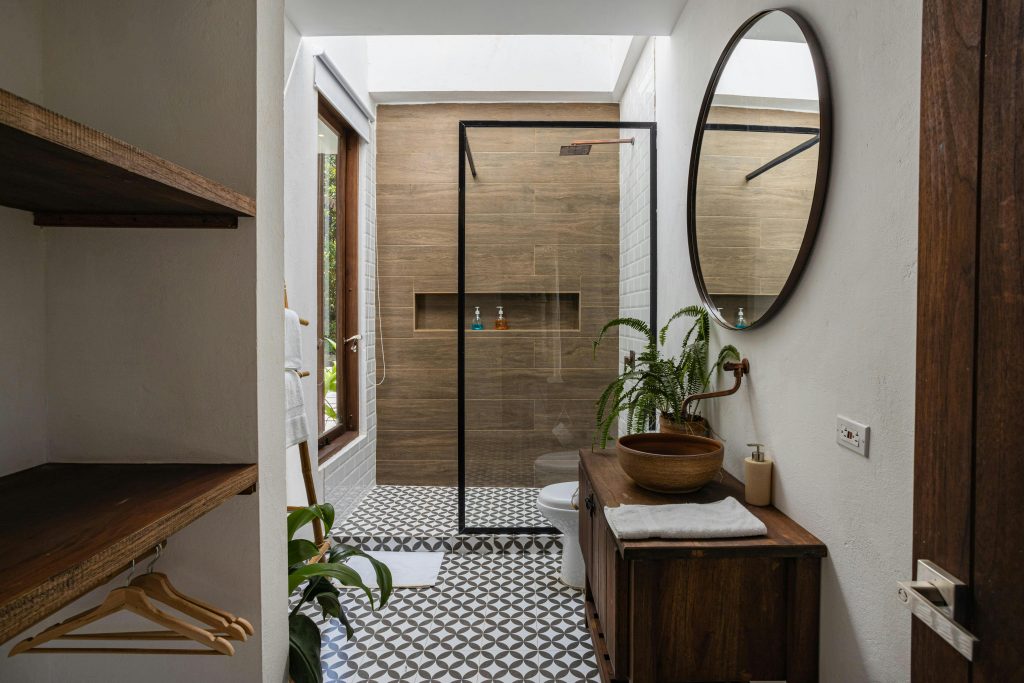Safe and Accessible Bathroom Designs for Aging in Place
Photo by Gustavo Galeano Maz from Pexels
Aging is a natural part of life, but it brings particular challenges, especially when maintaining independence at home. As we age, spaces that once felt safe and familiar, like our bathrooms, can become a concern. Slippery surfaces, high-step tubs, and tight corners suddenly represent obstacles to comfort and safety. For many people, the bathroom is a space where accidents can happen, raising an important question: how can we adapt our homes to support us as we grow older without compromising design or function?
There’s a growing trend of aging in place—staying in the comfort of one’s home instead of moving to assisted living. However, to make this goal realistic, some home renovations are necessary, especially in the bathroom, where safety must be a priority. Thoughtful planning can transform this space into one that balances beauty and accessibility. Fortunately, a bathroom can be stylish and safe with the right design choices, offering peace of mind without sacrificing aesthetics.
Imagine walking into a bathroom that suits your style and provides all the features needed to ensure safety as you age. From grab bars that blend seamlessly into the decor to barrier-free showers that offer both convenience and elegance, these design elements make aging in place a reality. The key is making choices that fit your needs while still maintaining an environment you love.
The decision to make your bathroom more accessible isn’t just about preparation; it’s about living confidently in your own space, knowing that it can adapt to your changing needs. Let’s explore the best strategies for creating a bathroom that grows with you, providing comfort, security, and style throughout the years.
1. Installing Grab Bars and Handrails for Added Safety
Grab bars and handrails are essential features in any bathroom designed for aging in place. They provide stability and support when moving around, especially in slippery areas like the shower or near the toilet. Placing grab bars near the shower entrance, within the shower itself, and beside the toilet provides stability and can significantly reduce the risk of falls.
When choosing grab bars, it is important to pick sturdy, high-quality materials that can support weight. They should be mounted securely so that they do their job when needed. Various styles and finishes are available, so you don’t have to sacrifice style for functionality. Some even come with added features like soap holders or shelves, which can further reduce the need to reach or bend down.
2. Convert Your Bathtub into a Shower
Walk-in showers are one of the most practical solutions for creating a safer bathroom. Traditional bathtubs require you to step over a high ledge, which can be challenging for seniors and increases the risk of falling. On the other hand, walk-in showers are designed with a low or no barrier at all, making them much easier to enter and exit.
One of the reasons to convert bathtub into a shower is the convenience it offers for people with mobility challenges. For seniors, stepping into a bathtub can be risky and uncomfortable. Converting the bathtub into a walk-in shower reduces the risk of falls, and you can add features like built-in seating and grab bars to make it even safer. Additionally, walk-in showers tend to take up less space, opening up your bathroom and making it feel more spacious.
3. Choosing Non-Slip Flooring for Bathroom Safety
Bathrooms are among the most common places for slips and falls, primarily due to wet, slippery floors. To reduce this risk, installing non-slip flooring in your bathroom is crucial. Non-slip floors, even when wet, provide extra traction and can help prevent accidents.
There are many flooring options available that are both safe and attractive. Vinyl flooring is a popular choice because it’s water-resistant and comes in a variety of designs. Another option is textured tile, which adds grip underfoot without feeling rough. Rubber flooring is another safe choice that offers excellent slip resistance, though it may not be as aesthetically pleasing for some. Whichever material you choose, the goal is to create a surface that reduces the likelihood of slips while still complementing the design of your bathroom.
4. Installing Higher Toilets for Comfort and Accessibility
Standard toilets are often too low for seniors or people with joint or mobility issues, making it challenging to sit down and get back up. This can lead to knee and back strain, increasing the risk of accidents or discomfort. To address this, you can install a comfort-height toilet, which is a bit taller than a standard one, making it easier to use.
Comfort-height toilets are designed to be closer to the height of a chair, reducing the strain on the knees and making it easier to sit down and stand up. Some models even have features like raised seats or built-in armrests for added support. These minor adjustments can make a big difference in the overall safety and comfort of the bathroom. Higher toilets are also beneficial for people recovering from surgery or anyone with temporary mobility issues.
5. Improving Bathroom Lighting for Better Visibility
Good lighting is often overlooked in bathroom design, but it’s essential for creating a safe space, especially for seniors. As we age, our eyesight tends to decline, which can make it harder to see in low-light areas. Poor lighting can lead to missed steps or slips, so it’s important to ensure that the bathroom is well-lit at all times.
One of the best ways to improve lighting in the bathroom is by installing bright, even lighting fixtures. LED lights are a great choice because they provide clear, bright light and are energy-efficient. Consider installing lights around the mirror to improve visibility when using the sink, and add overhead lights that cover the entire room. You can also install motion-sensor lights that automatically turn on when someone enters the room, reducing the need to fumble for a switch in the dark.
6. Adding Accessible Storage Solutions
Clutter can be a safety hazard in the bathroom, particularly if it leads to tripping or requires bending and reaching for items. Accessible storage solutions are an essential part of a safe bathroom design. Instead of traditional cabinets that require reaching or bending, consider installing pull-out drawers or adjustable-height shelving. These options keep essential items within easy reach and reduce the risk of strain or injury.
You can also install open shelving that keeps everything visible and accessible. Having frequently used items like toiletries or towels stored at a convenient height makes the bathroom easier to navigate. This way, everything you need is readily available without stretching or bending over, creating a more functional and safer space.
Designing for Comfort and Safety as You Age
As we look toward the future, designing a bathroom that prioritizes safety and style becomes essential to creating a home that serves you at every stage of life. By integrating thoughtful features like slip-resistant flooring, easy-access showers, and ergonomic fixtures, you can transform your bathroom into a safe haven that enhances your daily routine. The right design elements improve functionality and ensure that your space remains comfortable and aesthetically pleasing.
Investing in these modifications now allows you to enjoy the benefits of aging in place while maintaining your independence. Whether planning for the future or updating an existing bathroom, incorporating safety measures doesn’t mean compromising on beauty. With the right balance, you can create a bathroom that provides peace of mind and personal sanctuary for years to come.






